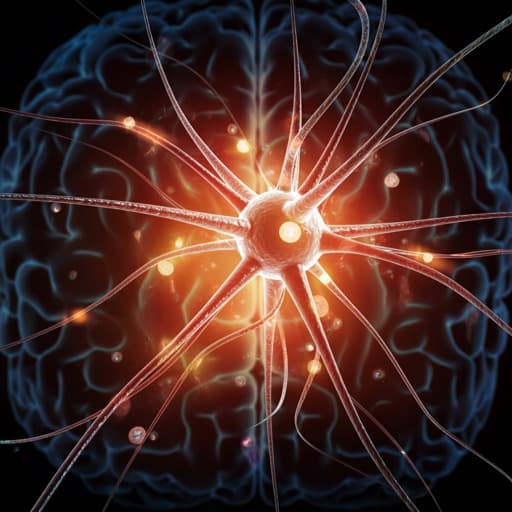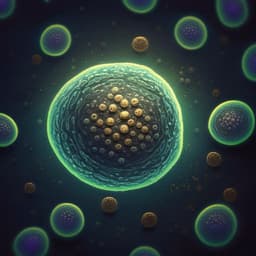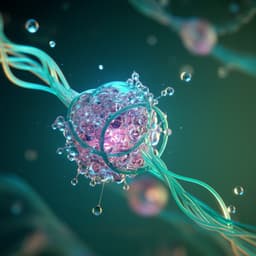
Medicine and Health
Neuroprotective Effects of Human-Induced Pluripotent Stem Cell-Derived Mesenchymal Stem Cell Extracellular Vesicles in Ischemic Stroke Models
G. Lu, X. Su, et al.
Discover the groundbreaking research by Gang Lu, Xianwei Su, Lihon Wang, Chi-Kwan Leu, Jingye Zhou, Zhiqiang Xiong, Wuming Wang, Hongbin Liu, and Wai-Yee Chan on the neuroprotective effects of extracellular vesicles derived from hiPS-MSCs in ischemic stroke. Their study reveals the potential of these EVs to reduce injury and promote recovery, paving the way for innovative cell-free therapies in stroke treatment.
~3 min • Beginner • English
Introduction
Stroke is the second leading cause of death and the primary cause of long-term disability worldwide, with ischemic stroke comprising approximately 80% of cases. Current reperfusion therapies (thrombolysis and mechanical thrombectomy) are time-limited, benefiting only a subset of patients, emphasizing the need for new neurorestorative strategies. Over the past two decades, extracellular vesicles (EVs) from stem cells, including exosomes, have emerged as key mediators of paracrine signaling and tissue regeneration. EVs are nanosized lipid bilayer vesicles carrying RNAs and proteins, capable of crossing the blood-brain barrier and modulating physiological and pathological processes. Prior work suggests MSC-derived EVs can promote neuroprotection, neurite outgrowth, immunomodulation, and neural repair after stroke. However, adult tissue-derived MSCs are limited by invasive harvesting and age-related declines in function. Induced pluripotent stem cell-derived MSCs (iPSC-MSCs) offer advantages such as abundant expansion potential and reduced ethical concerns, while newer non-integrating reprogramming methods mitigate genotoxicity risks. Despite these advantages, issues like immunological rejection and chromosomal variation remain concerns in cell transplantation. Given evidence that EVs may mediate much of MSCs’ therapeutic effects and can be produced from scalable iPSC-MSCs, the study investigates the neuroprotective potential of hiPS-MSC-derived EVs in both in vitro OGD/R neuronal models and in vivo mouse MCAO models, with particular focus on functional outcomes and angiogenesis markers (VEGF, SDF-1α/CXCR4).
Literature Review
The paper reviews the role of stem cell-derived EVs, particularly exosomes, in neurorestoration post-stroke. EVs and exosomes carry proteins, lipids, and nucleic acids that influence recipient cell behavior, including immune modulation and angiogenesis. Exosomes (40–100 nm) commonly express CD9, CD81, and CD63 and are isolated via methods like ultracentrifugation, although pure separation remains challenging. EVs can cross the blood-brain barrier, making them promising for neurological diseases. Prior studies show MSC-derived EVs improve neurovascular regeneration and functional recovery after ischemia in rodents and enhance angiogenesis while reducing immunosuppression. Allogeneic MSC-EVs (e.g., from Wharton’s Jelly) offer reduced immunogenicity and rich bioactive cargo for off-the-shelf therapy. iPSC-MSCs merge advantages of MSCs and iPSCs, including prolonged expansion and tri-lineage differentiation potential, with reduced tumorigenicity risk via non-integrating reprogramming methods. Previous studies demonstrated iPSC-MSC-EVs promote angiogenesis in limb ischemia and wound healing, but their application to angiogenesis in ischemic stroke models had not been reported. The review notes variability in outcomes across studies due to differences in species, EV sources, dosing, and protocols, and highlights microenvironmental influences on EV cargo (e.g., miR-133b), underscoring the need to characterize EVs under disease-relevant contexts.
Methodology
Animal model and experimental design: Male adult C57BL/6J mice (10–12 weeks; 25–30 g) underwent transient MCAO using the intraluminal filament method. Under anesthesia, the LCCA and LECA were ligated; microvascular clips were placed on the LICA and LPA; a monofilament was inserted into the LICA to occlude the MCA for 60 minutes in a heated cage, then withdrawn to allow reperfusion. Sham mice underwent the same procedure without actual MCA occlusion. All procedures were approved by CUHK ethics committee (Ref No. 18-121-ITS). hiPS-MSC generation: Human iPSC lines (Advanced Cell Technology Limited, affiliated with Shandong University) were maintained on Matrigel in mTeSR1 medium. At confluence, cells were switched to KOSR + SB medium (DMEM/F12 + 20% KOSR, 1 mM L-glutamine, 10 mM NEAA, 10 µM SB431542) replaced daily for 10 days. Cells were dissociated (TrypLE Select) and reseeded at 40,000 cells/cm2 in MSC medium; subsequent replating at 20,000 cells/cm2 with MSC medium (DMEM + 10% FBS, 1% pen/strep, 2 mM L-glutamine, 0.1 mM NEAA), passaged every 5–7 days until fibroblast-like morphology and MSC phenotype. Multipotency assays: Osteogenesis with osteogenic medium for 3 weeks (Alizarin Red staining), chondrogenesis for 4 weeks (Alcian Blue), adipogenesis for 2 weeks (Oil Red O). Imaging by Leica system. Flow cytometry of MSC markers: After 4–5 passages, cells were blocked with 3% BSA and stained with APC-CD73, PerCP-CD105, FITC-CD90; negative cocktail PE-CD45/CD34/CD11b/CD19/HLA-DR (BD kit). Analysis on BD LSR Fortessa; >95% positive for CD73/CD90/CD105; negative markers <2%. EV isolation and characterization: hiPS-MSCs were grown to 80% confluence, then conditioned in exosome-free medium (10% exosome-free FBS in MSC medium) for 48 h. CM was cleared at 300×g 10 min, 2000×g 10 min, filtered (0.22 µm), concentrated by ultrafiltration (Amicon Ultra-15, 100 kDa) to ~200 µL, washed with PBS, and reconcentrated. Protein quantified by BCA. TEM imaging (Hitachi HT-7700) after uranyl acetate staining showed 50–100 nm cup/round vesicles. Western blotting detected exosomal markers CD9, CD63, CD81; calnexin absent; tubulin loading control. EV surface markers assessed by bead-based flow cytometry: EVs captured on anti-CD9 or anti-CD81 magnetic beads and stained with anti-CD63-PE, yielding CD63 positivity of ~95.7% (CD9 beads) and ~97.8% (CD81 beads). RNA from EVs extracted with TRIzol-LS; RNA size by Agilent Bioanalyzer showed small RNA peaks (25–200 nt). Nanoparticle analysis by Flow NanoAnalyzer (NanoFCM N30E) with silica/polystyrene bead calibration showed size distribution mostly 50–100 nm; mean diameter ~70.25 nm. OGD/R in vitro model: HT22 murine hippocampal cells were cultured in DMEM high glucose + 10% FBS. Before OGD, medium was replaced with DMEM + 10% exosome-free FBS. For OGD, glucose-free deoxygenated DMEM without FBS was used; cells were placed in a hypoxia chamber (95% N2/5% CO2) for 2 h (tested 10 min to 6 h to optimize; 2 h used for experiments), followed by reoxygenation for 24 h in medium with exosome-free FBS, or without FBS, or with EVs (20, 50, 100 µg/mL; main experiments at 100 µg/mL). Proliferation and apoptosis assays: MTT assay measured viability at 24, 48, 72 h post-OGD/R. Apoptosis assessed by Annexin V-Alexa Fluor 488/PI staining and flow cytometry (BD LSR Fortessa). RNA sequencing: Nine samples in three groups (control, OGD + PBS (OGP), OGD + EVs (OGE)); RNA integrity by Bioanalyzer 2100. Libraries sequenced on Illumina NovaSeq 6000 (paired-end 150 bp; ~70M clean reads/sample). Alignment by HISAT2; counts by FeatureCounts; DEGs by DESeq2 with fold change ≥1.5 and adjusted p ≤ 0.05. Ingenuity Pathway Analysis (IPA) performed for upstream regulators, networks, diseases/disorders. Neurological assessments in vivo: Behavioral testing (Zea-Longa score 0–4 and modified Neurological Severity Score (mNSS) 0–14) on days 0, 3, 14, and 28 post-MCAO (n = 4–6 per group; figures indicate n = 4 for behavior). Histology and lesion volume: H&E staining of paraffin sections (5 µm) at 100 µm intervals. Lesion volume (%) = (contralateral volume − ipsilateral intact volume) / contralateral volume × 100. Immunohistochemistry and Western blot: IHC for VEGF (Abcam ab51745), SDF-1α (Santa Cruz sc-518066), and CXCR4 (Abcam ab181020) with DAB detection and hematoxylin counterstain. Western blots on infarcted hemispheres at day 28 for VEGF, CXCR4, SDF-1α; HRP secondary (1:2000). Statistics: Data mean ± SD. Student’s t-test for two groups; two-way ANOVA with post hoc for multiple comparisons. Significance at p < 0.05.
Key Findings
- hiPS-MSCs were successfully generated from human iPSCs, displaying fibroblast-like morphology, tri-lineage differentiation (osteogenic, adipogenic, chondrogenic), and MSC surface marker profile (>95% CD73/CD90/CD105; <2% negative cocktail). - EVs isolated from hiPS-MSCs were 50–100 nm by TEM, mean ~70.25 nm by NanoFCM; expressed CD9, CD63, CD81, and lacked calnexin; bead-based flow cytometry showed CD63 positivity of 95.7% (after CD9 bead capture) and 97.8% (after CD81 bead capture). EV RNA contained predominantly small RNAs (25–200 nt). - In vitro OGD/R (2 h OGD) reduced HT22 viability; hiPS-MSC-EVs improved viability in a dose-dependent manner (20, 50, 100 µg/mL), with significant proliferation increases at 24, 48, and 72 h versus OGD controls at 100 µg/mL. - EV treatment reduced apoptosis after OGD/R: apoptotic cells decreased from 9.7% (PBS) to 2.8% (EVs) by Annexin V/PI flow cytometry; morphology showed reduced apoptotic features with EVs. - RNA-seq and IPA identified DEGs associated with ischemic injury and EV treatment, implicating upstream regulators (e.g., STAT3, TP53, PGR, CEBPA, HIF1A for OGD vs control; Trim24, Irf7, Irf3, Stat1, Cited2 for OGE vs OGP) and enriched disease/pathway networks related to inflammation, immune response, and tissue injury. - In vivo, hiPS-MSC-EVs improved neurological outcomes post-MCAO: Zea-Longa scores were elevated by MCAO versus shams; mNSS scores decreased over time in MCAO+EV group with significant improvement by day 28 compared to MCAO+PBS (n = 4 per group; two-way ANOVA). - Lesion volume at day 28: MCAO+PBS 57.08% ± 4.48% versus MCAO+EV 50.76% ± 2.91%, indicating reduced infarct size with EV treatment; no differences between sham+PBS and sham+EV. - Angiogenesis-related markers: VEGF significantly increased in MCAO+EV versus MCAO+PBS by IHC and Western blot; CXCR4 showed a similar but less pronounced increase; SDF-1α showed no significant difference by IHC. Overall, EVs promoted angiogenesis in the ischemic border zone. - Collectively, hiPS-MSC-EVs enhanced neuronal survival/proliferation in vitro and improved functional recovery, reduced infarct size, and increased angiogenesis markers in vivo, supporting a neuroprotective role in ischemic stroke models.
Discussion
The study demonstrates that hiPS-MSC-derived EVs confer neuroprotection in both cellular and animal ischemic stroke models. In vitro, EVs mitigated OGD/R-induced cytotoxicity by enhancing HT22 cell viability and reducing apoptosis, suggesting EV cargo (e.g., small RNAs, proteins) modulates survival pathways. In vivo, EVs administered intravenously after MCAO improved behavioral outcomes (mNSS) by day 28 and reduced lesion volume, indicating tissue preservation and functional recovery. The increased expression of angiogenesis-related proteins (VEGF, CXCR4) in the ischemic hemisphere supports a mechanism involving vascular remodeling and neurorestoration. These findings align with prior reports that MSC-derived EVs promote neurovascular plasticity and functional recovery after stroke, while offering advantages of a cell-free approach that potentially reduces risks linked to live cell transplantation (immune rejection, tumorigenicity, microvascular occlusion). Differences across literature in functional outcomes may be due to species, EV sources, dosing, and protocols. The transcriptomic analyses implicate key regulators (e.g., STAT3, HIF1A, IRFs, STAT1) in ischemic injury and EV-mediated modulation, suggesting EVs may dampen detrimental inflammatory responses and support reparative processes. Overall, the data address the research question by showing hiPS-MSC-EVs can improve neurologic function and reduce infarct burden while enhancing angiogenesis, thus representing a promising neurorestorative strategy for ischemic stroke.
Conclusion
hiPS-MSC-derived EVs inhibit apoptosis and promote proliferation in an HT22 OGD/R model and improve neurological recovery (motor function, reduced lesion volume) with enhanced angiogenesis (increased VEGF and CXCR4) in a mouse MCAO model. These results advance understanding of hiPS-MSC-EV function and support their development as a cell-free therapeutic strategy for ischemic stroke. Future work should delineate EV cargo and mechanisms, optimize dosing and timing, expand angiogenesis and inflammatory marker panels, include both sexes and larger cohorts, and assess long-term safety and efficacy, including translation toward human studies.
Limitations
- Small sample sizes limit statistical power and generalizability. - Only male C57BL/6 mice were used, limiting applicability to females and potential sex-specific responses. - Species differences constrain direct translation to humans. - The HT22 OGD/R in vitro system simplifies the complex ischemic brain milieu. - Angiogenesis assessment focused on VEGF and CXCR4; broader marker panels are needed for comprehensive analysis. - The observation window did not address long-term durability or potential adverse effects of EV therapy. - Variability in EV isolation and characterization methods may affect yield/purity and reproducibility.
Related Publications
Explore these studies to deepen your understanding of the subject.







